Related Research Articles

The Highland Railway (HR) was one of the smaller British railways before the Railways Act 1921, operating north of Perth railway station in Scotland and serving the farthest north of Britain. Based in Inverness, the company was formed by merger in 1865, absorbing over 249 miles (401 km) of line. It continued to expand, reaching Wick and Thurso in the north and Kyle of Lochalsh in the west, eventually serving the counties of Caithness, Sutherland, Ross & Cromarty, Inverness, Perth, Nairn, Moray and Banff. Southward it connected with the Caledonian Railway at Stanley Junction, north of Perth, and eastward with the Great North of Scotland Railway at Boat of Garten, Elgin, Keith and Portessie.

The Highland Main Line is a railway line in Scotland. It is 118 mi (190 km) long and runs through the Scottish Highlands linking a series of small towns and villages with Perth at one end and Inverness at the other. Today, services between Inverness and Edinburgh, Glasgow and London use the line. At Inverness the line connects with the Far North Line, the Aberdeen-Inverness Line and services on the Kyle of Lochalsh Line. All trains are diesel-powered.

The Kyle of Lochalsh Line is a primarily single track railway line in the Scottish Highlands, from Dingwall to Kyle of Lochalsh. Many of the passengers are tourists, but there are also locals visiting Inverness for shopping, and commuters. All services are provided by ScotRail and run beyond Dingwall to Inverness. In the past there were some through services to and from Glasgow, Edinburgh or Aberdeen. None of the line is electrified, and all trains on the line are diesel-powered, as are all other trains in the Scottish Highlands.
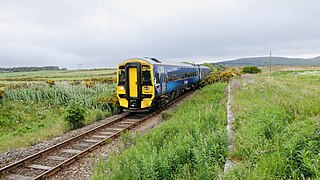
The Far North Line is a rural railway line entirely within the Highland area of Scotland, extending from Inverness to Thurso and Wick. As the name suggests, it is the northernmost railway in the United Kingdom. The line is entirely single-track, with only crossing loops at some intermediate stations allowing trains to pass each other. In common with other railway lines in the Highlands and northern Lowlands, it is not electrified and all trains are diesel-powered.

Dingwall railway station serves Dingwall, Scotland. It is located just south of the junction of the Far North Line and the Kyle of Lochalsh Line, and is served by ScotRail. The station is 18 miles 58 chains (30.1 km) from Inverness, and is the zero point for the Kyle of Lochalsh Line. It is sited after Conon Bridge heading northbound, with the next station being either Garve or Alness.

Aviemore railway station serves the town and tourist resort of Aviemore in the Highlands of Scotland. The station, which is owned by Network Rail (NR) and managed by ScotRail, is on the Highland Main Line, 83 miles 31 chains from Perth, between Kingussie and Carrbridge, and is also the southern terminus of the Strathspey preserved railway.

Inverness railway station is the railway station serving the Scottish city of Inverness. It is the terminus of the Highland Main Line, the Aberdeen–Inverness line, the Kyle of Lochalsh line and the Far North Line.
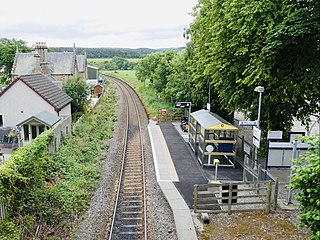
Beauly railway station is a railway station in the village of Beauly, in the Highland council area of Scotland. Located on the Far North Line, it is 10 miles 12 chains (16.3 km) down the line from Inverness, and it is the first intermediate station on the line, before reaching Muir of Ord.

Achnasheen railway station is a remote railway station on the Kyle of Lochalsh Line, serving the village of Achnasheen in the north of Scotland.
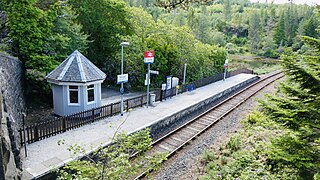
Duncraig railway station is a remote railway station by the shore of Loch Carron on the Kyle of Lochalsh Line, serving Duncraig Castle, a mansion near Plockton, in the Highland council area of northern Scotland. It was originally a private station, and features a small, unique octagonal waiting room. The station is unstaffed and is a request stop.

Kyle of Lochalsh railway station is the terminus of the Kyle of Lochalsh Line in the village of Kyle of Lochalsh in the Highlands, northern Scotland.

Wick railway station is a railway station located in Wick, in the Highland council area in the far north of Scotland. It serves the town of Wick and other surrounding areas in the historic county of Caithness, including Staxigoe, Papigoe and Haster. The station is the terminus of the Far North Line, 161 miles 36 chains from Inverness. It is managed by ScotRail, who operate all trains serving the station.

Nairn railway station is a railway station serving the town of Nairn in Scotland. The station is managed by ScotRail and is on the Aberdeen to Inverness Line. It is a category B listed building. The station appeared as 'Inverness' in the 1970 film The Private Life of Sherlock Holmes.

Elgin railway station is a railway station serving the town of Elgin, Moray in Scotland. The station is managed by ScotRail and is on the Aberdeen to Inverness Line.
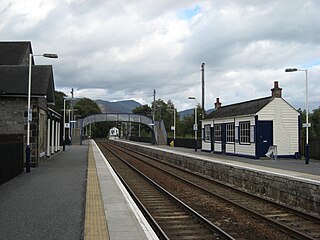
Blair Atholl railway station is a railway station serving the town of Blair Atholl, Perth and Kinross, Scotland. The station is managed by ScotRail and is on the Highland Main Line.
The Dingwall and Skye Railway was authorised on 5 July 1865 with the aim of providing a route to Skye and the Hebrides. However, due to local objections, another Act of Parliament was required before work could commence. This was passed on 29 May 1868.
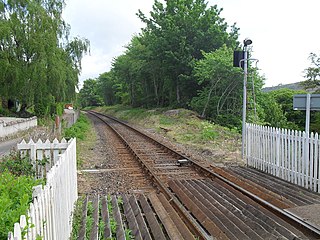
Achterneed railway station was a railway station serving Strathpeffer and located on the Kyle of Lochalsh Line, in Wester Ross, Scotland.

Conon Bridge is a railway station on the Far North and Kyle of Lochalsh Lines, which serves the villages of Conon Bridge and Maryburgh in the Scottish Highlands. Initially known as Conon, it originally closed in 1960 and reopened on 8 February 2013. The station is 16 miles 21 chains (26.2 km) from Inverness, between Muir of Ord and Dingwall.

Strathpeffer railway station was a railway station serving the town of Strathpeffer in the county of Ross and Cromarty,, Scotland. The first station was located some distance from the town, on the Dingwall and Skye Railway line, and was opened in 1870.
The Lewisman was a named passenger train operating in the United Kingdom.
References
- ↑ Allen, Cecil J. (1967). Titled Trains of Great Britain. Ian Allan Ltd. p. 95.
- ↑ "Scots names for Scots trains" . Shields Daily News. England. 13 June 1933. Retrieved 25 November 2017– via British Newspaper Archive.
- ↑ "BR introduce The Hebridean" . Aberdeen Press and Journal. Scotland. 23 January 1965. Retrieved 25 November 2017– via British Newspaper Archive.